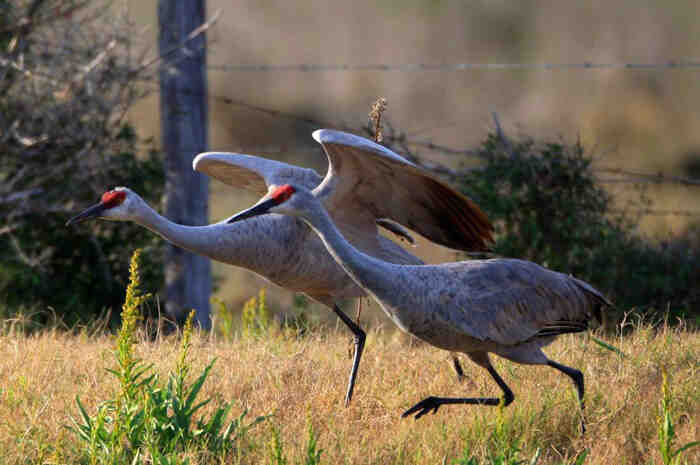Grus canadensis
IUCN
LCBasic Information
Scientific classification
- name:Grus canadensis
- Scientific Name:Grus canadensis,Brown Crane, Canada Crane
- Outline:Wading birds
- Family:Gruiformes Grus
Vital signs
- length:100-110cm
- Weight:4.02-4.57kg
- lifetime:About 35 years
Feature
The face is white, the forehead and crown are red, and the whole body feathers are gray with brown.
Distribution and Habitat
Sandhill cranes are mainly distributed in North America, Cuba and northeastern Siberia. Most of the wintering sandhill cranes are concentrated in national nature reserves in the United States.
Distributed in Canada, China, Cuba, Japan, South Korea, Mexico, Russia, and the United States.
Migrant birds: Bermuda Islands (western North Atlantic Islands), Faroe Islands, Greenland (island name, located in the northeast of North America, belonging to Denmark), Ireland (island), Netherlands, Saint Pierre and Miquelon Islands, Turks and Caicos Islands, and the United Kingdom.
Sandhill cranes live in plain swamps rich in shrubs and aquatic plants, lakeside grasslands, ponds and riverside swamps, and sometimes appear in plateau areas with trees and herbs.
Appearance
The plumage is grey with brown, lighter underparts. The forehead, front of the eyes and the front of the head are exposed, bright red, with sparse hair-like bristles. The chin and throat are white. There are 11 primary flight feathers, the third is the longest, the flight feathers are dark brown, and the tertiary flight feathers are extended into an arch, with the barbs at the ends separated and covering the tail feathers. There are 12 tail feathers, short and straight. The long legs are almost black. The face is white, with a red forehead and crown, and dark grey flight feathers can be seen in flight. The iris is yellow; the bill is grey; the feet are grey.
Details
Sandhill Crane is a large wading bird with the largest number of cranes in the world. It is divided into 6 subspecies with a total of more than 800,000 individuals. However, there are about 120 individuals in the Mississippi species and less than 100 individuals in the Cuban subspecies. Both are endangered. China only has the named subspecies, which has been observed in Shanghai, Jiangsu, Jiangxi, Shandong, Beijing, Hebei, Jilin, Heilongjiang and Liaoning. It may be a lost bird.

Sandhill cranes often move in family groups. They are alert and timid. They often hide in bushes and tall grasses, only sticking their heads and necks above the bushes or grasses. They will take off immediately if there is any danger. When taking off, they need to run a distance on the ground before they can fly, while making loud calls.
Sandhill cranes mainly feed on leaves, buds, grass seeds and grains of various shrubs and herbs, and also eat some insects.
The breeding season of sandhill cranes is from May to July. The mate is a monogamous system, and they begin to pair up and court soon after arriving at the breeding ground. When courting, the male and female birds constantly sing, jump and dance to each other, fly into the air together, and then fall to the ground. Nests are built in bushes or sand close to the water. Parent birds often dig a shallow pit with a diameter of about 60 cm on the ground, and the pit is covered with dead grass and feathers. Each nest lays 1-2 eggs, which are oval in shape and range in color from cinnamon brown to olive brown.
The 10,000-hectare Gleh Lake Swamp in Florida, USA, is a typical concentration camp nesting site for sandhill cranes. They are rarely found in other places, and no valuable data on the distribution of sandhill cranes has been obtained for more than 30 years.
The main endangering factors for sandhill cranes are: industry, water conservancy, fishing, grazing, land reclamation, watering and reed cultivation, and reed cutting, which destroy their habitats. Natural enemies eat their eggs and chicks, such as raptors, ravens, weasels, scorpions, wolves, red foxes, etc.
Listed in the 2016 Red List of Endangered Species of the World Conservation Union (IUCN) - Low Concern (LC).
Among them, the Cuban subspecies and the Florida subspecies of the sandhill crane are listed as Class I protected animals under the CITES of the Washington Convention, and all other subspecies of the sandhill crane are listed as Class II protected animals under the CITES of the Washington Convention.
Listed in the China National Secondary Key Protected Wildlife List.
Protect wild animals and stop eating game.
Maintaining ecological balance is everyone's responsibility!








